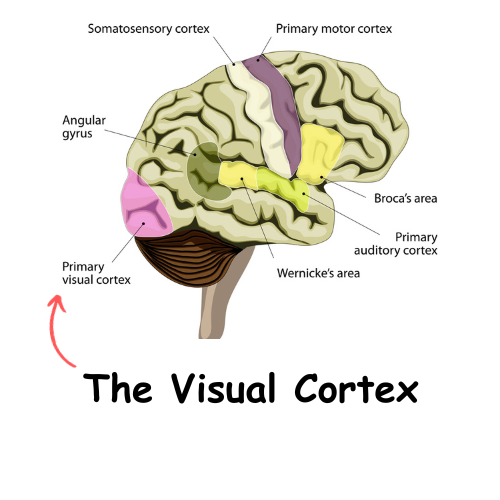What is the Visual Cortex?


The visual cortex is a region in the brain that plays a fundamental role in processing visual information received from the eyes. It is located at the back of the brain in the occipital lobe and is responsible for interpreting and making sense of the visual input that we perceive through our eyes.
Here’s a breakdown of how the visual cortex works:
Reception of visual input:
The process begins with the eyes capturing visual stimuli from the environment. Light enters the eyes through the cornea, passes through the lens, and forms an image on the retina at the back of each eye.
Transmission to the brain:
The retina contains specialized cells called photoreceptors (rods and cones) that convert light into electrical signals. These signals are then transmitted through the optic nerve, which carries the visual information from each eye to the brain.
Visual pathway:
The optic nerve fibers from each eye partially cross at the optic chiasm, and then continue as the optic tract. These fibers ultimately project to the lateral geniculate nucleus (LGN) of the thalamus. From the thalamus, visual information is relayed to the visual cortex.
Primary visual cortex (V1):
The primary visual cortex, also known as V1 or the striate cortex, is the first area in the visual cortex to receive visual input. It is highly involved in the initial processing of visual information, such as edge detection, orientation, and basic feature analysis. The cells in V1 respond to specific patterns of light and dark.
Processing in higher visual areas:
Visual information then flows through a series of higher visual areas beyond V1, each responsible for more complex aspects of visual perception. These areas are involved in recognizing objects, faces, colors, motion, and other visual attributes.
Integration and perception:
The visual cortex integrates information from different parts of the visual field and combines it with input from other sensory modalities. This integration contributes to our perception of the visual world, allowing us to recognize objects, navigate our environment, and interact with what we see.
Neuroplasticity:
The visual cortex exhibits neuroplasticity, meaning it can adapt and reorganize in response to changes in sensory input. This adaptability allows the brain to adjust to new visual experiences, such as during the learning process or when using corrective lenses like glasses.
In summary: The visual cortex is a complex network of neurons that works in layers to decipher what our eyes see. It starts with simple things in one part -the primary visual cortex and passes the information to other parts of the more complex higher visual area that figures out the more complicated details.
Gregory Scimeca, M.D.
Ophthalmologist and Medical Director
The Eye Professionals
Our Locations
